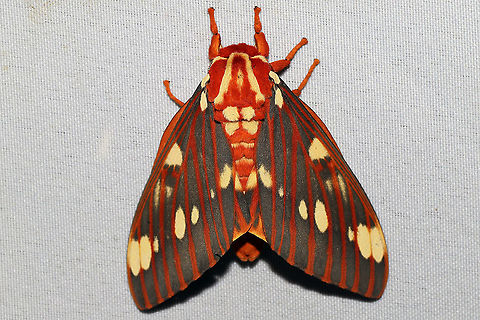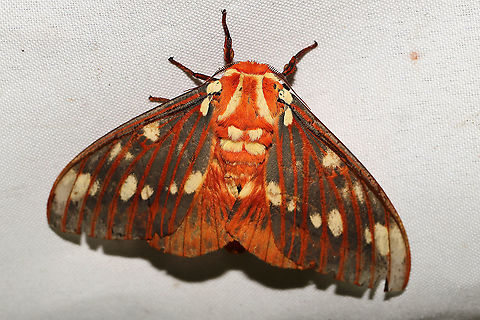
Appearance
''Citheronia regalis'' The adult moth is the largest moth by mass in latitudes north of Mexico, as are the spectacular larva and the substantial pupa.
Behavior
The life cycle of the moth is typical of the Saturniidae species, and typical of the Ceratocampinae. It burrows into the ground to pupate in an earthen chamber, rather than spinning a cocoon.Yellowish eggs, oval and 2 mm in diameter, are laid either singly or in groups of up to four on the upper surface of the host plant leaves, favoring nut trees such as ''Juglans'' and ''Carya'' . There are regional preferences, with the utilization of sweet gum and persimmon in the south, and sumacs where the others are not available. Larvae are solitary in later stages and rarely occur in numbers large enough to cause defoliation, however an individual larva can strip several branches of their leaves during the ravenous 5th instar.
When the eggs hatch 7–10 days later, small yellow larvae that darken rapidly emerge. The caterpillars are solitary nighttime feeders in early stages, when they curl up in a "j" shaped pattern during the day and resemble two-toned bird droppings.
As the caterpillars age, they feed during the day. They molt 4 times. Each instar is different, but on their fifth and final instar they become a bright green color, with huge, black-tipped red horns, earning them their common name "hickory horned devils". They feed heavily on their host plant for 37 – 42 days and can grow up to 15 centimetres long. Their scary appearance is purely a ruse; the spines, though prickly, do not sting, and the larva is harmless and actually one of the more easily handled of the saturniidae.
Just before pupation, the larva expels its gut and changes color from green to turquoise, the skin of the fully fed creature stretched shiny and tight. They then crawl down the host plant, where they burrow into the dirt and pupate in a well formed chamber at a depth of five to six inches. The pupae are dark brown/black in color, and have a relatively short cremaster. Some pupae overwinter for 2 seasons, perhaps as an adaption to variable and adverse conditions such as fires and flooding, or to maintain genetic diversity across generations.
When the moths eclose, they have to pump their wings with fluid to extend them. The females emit pheromones, which the male can detect through its large, plumose antennae. Males can fly for miles in order to reach a female. After the moths mate, the female spends the majority of the remainder of her life laying eggs, while the male may mate several more times. Adults of this family of moths have vestigal mouths, meaning their mouthparts have been reduced. Because of this, they do not eat and only live for about a week as adults.
There is a single generation of ''Citheronia regalis'' throughout its range, but in the deep south, moths have been recorded throughout the longer growing season. Typically, ''Citheronia regalis'' is a midsummer moth, on the wing from late June through August. There is a distinct bell curve to the emergence, with peak-weeks coinciding with the first spell of the humid summer weather which may synchronize emergences.

Food
The general list of recorded hosts contains hickories, Buttonbush, Filbert, Bush honeysuckle, Persimmon, Ash, Cotton, Butternut, Black walnut, English walnut, Sweetgum and Privet among others.References:
Some text fragments are auto parsed from Wikipedia.